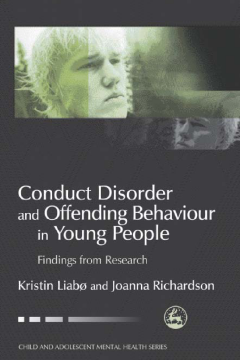
BOOK
Conduct Disorder and Offending Behaviour in Young People
Joanna Richardson | Kristin Liabo
(2007)
Additional Information
Book Details
Abstract
`This is the latest in a series of accessible, evidence-based resources from Jessica Kingsley Publishers for those seeking to understand and promote young people's mental health. Trawling through the evidence, the authors start by looking at the nature and prevalence of conduct disorders including attention-deficit hyperactivity disorder and how they relate to factors such as depression, substance misuse and learning disabilities. They also look at preventive methods and services available to adolescents in the wake of Ever Child Matters. The book then deals with different approaches to treatment, from individual programmes using cognitive behaviour therapy to family, school-based and pharmacological interventions. It suggests family therapies are the most promising, with little evidence supporting the efficacy of medication.'
- Youth Work Now
Offending behaviour in young people is a problem not only for affected neighbours and communities; it is also a serious problem for the young people involved. Behaviour problems and involvement in criminal activities have been linked to continued offending, substance misuse, lack of education and work - all factors that are linked, in turn, with shorter life expectancy.
This book reviews the literature on a number of techniques and treatment approaches designed for use with adolescent conduct disorder and young offenders. The authors also provide an overview of the condition including its developmental pathway; the criteria for diagnosing conduct disorder, and services for adolescents.
Conduct disorder and offending behaviour in young people are complex problems that need multi-agency, multifaceted solutions. This book aims to contribute to the design of services by drawing on a wide range of high-quality research, and presents it for the non-specialist. It is essential reading for child and adolescent mental health practitioners, social workers, youth offending teams and other professionals working with young people with conduct problems and their families.
As a system supervisor over programs that service just suth youth, I appreciate the distilled, balanced, and carefully articulated account of what is known, what is not known, and what is emerging in this area. Any clinician who wishes to place his or her hard-earned clinical approaches within the context of the research base will not be disappointed.
PsycCritiques
Kristin Liabø is a research fellow in the Social Science Research Unit at the Institute of Education, London, UK. Joanna Richardson was a senior development officer for the FOCUS project. She is now an analyst for the National Institute for Health and Clinical Excellence (NICE), London, UK.
Today's media tends to portray antisocial behaviour in children and adolescent simply as a problem for local communities and neighbourhood watch groups. Drawing on their experience as researchers in the field of conduct disorder, Liabo and Richardson seek to change this perception by focussing on the needs of the young people involved. The importance of this topic is reinforced on the basis that behaviour problems and criminal activity are linked to poor education, lack of employment, continuing offending and substance misuse. This book will appeal to a variety of readers ranging from those who just require basic information to mental health professionals who need to further enhance their knowledge. Useful appendices contain research strategy terminology and critical appraisal, providing assistance for potential academics in the subject matter. The overall result is a book which actually provides precise material on a complex problem pitched at appropriate levels for all likely readers.
Journal of Mental Health
Table of Contents
| Section Title | Page | Action | Price |
|---|---|---|---|
| Preface | |||
| List of Figures | |||
| List of Tables | |||
| 1. INTRODUCTION | |||
| 1.1 Purpose of this Handbook | |||
| 1.2 Windpump technology is time-proven | |||
| A brief history of windpumps | |||
| Past experience with windpump designs | |||
| 1.3 The wind.energy resource | |||
| The effect of wind speed | |||
| The effect of air density | |||
| Energy availability | |||
| How to find the amount of energy available | |||
| from the wind | |||
| 1.4 Choices of energy resource 9 | |||
| 2. WINDPUMP DESIGN - STATE OF THE ART 11 | |||
| 2.1 Principles of wind energy conversion: Lift and 11 | |||
| drag | |||
| 2.2 Rotor design 13 | |||
| Pitch | |||
| Solidity | |||
| Tip-speed ratio | |||
| Performance coefficient | |||
| Torque | |||
| 2.3 Pump types | |||
| 2.4 Transmissions, tails and towers | |||
| Transmissions | |||
| Tails | |||
| Towers | |||
| 2.5 The feasibility of local manufacture | |||
| The advantages | |||
| Criteria for success | |||
| Types of design suitable for local manufacture | |||
| 3. SITE EVALUATION 25 | |||
| 3.1 Assessing the wind regime 25 | |||
| The wind regime parameters needed | |||
| Wind measurement | |||
| Quality of wind data | |||
| Measurement options | |||
| Choosing the windpump site |
